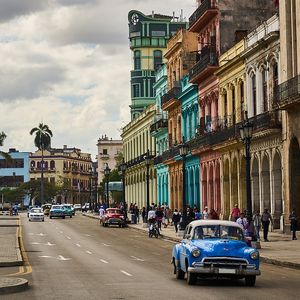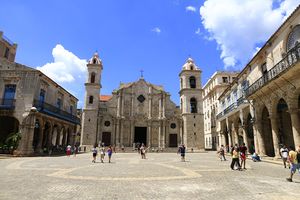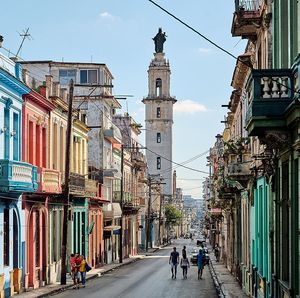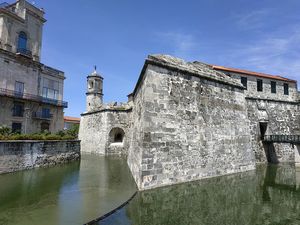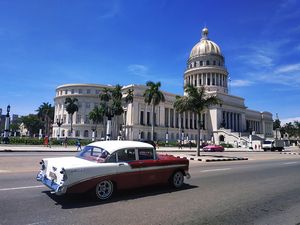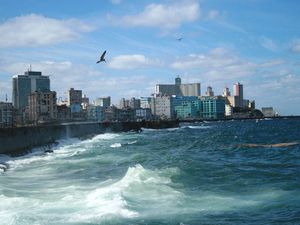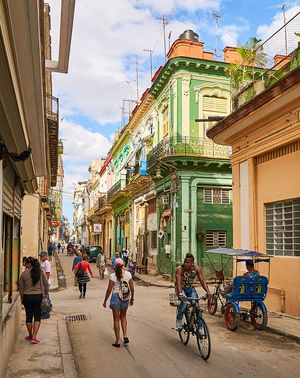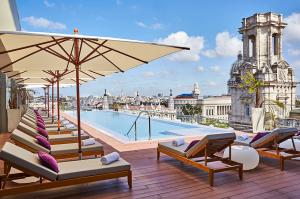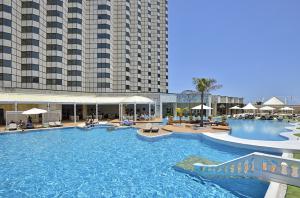

Havana, Cuba
Visit Havana, the capital of Cuba, and discover the perfect getaway in this fantastic and diverse city full of joy, culture, music and color
La Habana (Havana), the capital of Cuba, is a city full of oppositions and contradictions. Its’ main attractions are its beautiful historic center, exceptional architecture, the revolutionary Cuban iconography (from El Malecon to the Plaza de la Revolución (Revolution Square), passing by La Giraldilla) and its broad range of cultural offers, which makes the Havana village one of the best destinations to visit in Latin America.
The history of Havana is truly fascinating, and in it you can find interesting museums, impressive restoration projects, and a magnificent artistic and cultural heritage. Paintings, murals, novels, poetry, puntos cubanos (a Cuban music genre mixed with poetry), rumbas, the wonderful feeling in the fun Havana streets and the colorful murals will delight your senses. You will discover, behind every corner, all that this wonderful city can offer: from street music to the cabaret.
One of the more attractive aspects of Havana is to see how everyday life pans out in the city: happy children playing baseball on the street, street troubadours, a group of people doing maintenance on a Plymouth from 1955 in the middle of the street… and the peculiar way in which the people of Havana, the habaneros, project themselves, create, and live above all, enjoying life. Learn about their stories and the passions that move them as you enjoy an entertaining game of dominos and the atmosphere of tranquility that the city breathes.
Variety and color aren’t only shown through the habanero art and culture, as the city’s mobile carpark is one of the most impressive in the world. Hundreds of classic cars from different eras and styles make this mobile park one of the most iconic in the world. Taking a ride in one of these spectacular vehicles will make your journey a true luxury of a whole other era.
The capital of Cuba amazes, with its lively nightlife and music culture that flows from all the boulevards of life. Life in Havana is spectacular, where all the musical styles are represented and live with great frenzy. The city offers a wide range of live and impromptu concerts, and in many streets and plazas you will find great local artists.
index
What is there to see in Havana?
To get to know Havana, at least three days are needed; although it is recommended to stay for at least one week. The areas wherein most points of interest are concentrated are: La Habana Vieja (Old Havana), Centro Habana (Havana Center) and Vedado.
The different neighbourhoods Havana is divided into have unique qualities that make them wonderful places and above all places that you can’t miss on your trip to Havana, Cuba.
Old Havana located in the east of the city, facing the bay, is the supposed masterpiece of the city, located where the town was initially founded. Havana Center, is a neighbourhood located in the north and central part of the city that offers a vast view of Cuba and hosts a great number of emblematic sites; while Vedado, officially known as Plaza de la Revolucion (Revolution Square) and it’s most impressive area being the old fiefdom of the Mafia, is full of hotels and restaurants, with a lively nightlife. This municipality is the commercial and residential center of Havana.
It is impossible to imagine a trip to Havana without visiting Old Havana, enjoying its four main squares which were birthed in the colonial era and visiting its interesting museums to learn its history. The historic quarter occupies 4 square kilometers full of history and tradition in all its corners, where you will find numerous monuments and museums of different themes.
Old Havana is one of the most peaceful and safest areas in all of Latin America. It was also declared a World Heritage Site by UNESCO. The best way to get to know it is to walk through its streets, get lost in its alleys and create routes with your own senses. Spending time in any area of this iconic neighbourhood will make your journey a fantastic experience. Among its points of interests are the Museo de la Ciudad (Museum of the City), Museo de Arte Colonial (Museum of Colonial Art), Plaza de Armas, the Catedral de San Cristóbal de La Habana (San Cristóbal de La Habana Cathedral), the Monasterio de San Francisco de Asís (Monastery of San Francisco de Asís), and the Castillo de la Real Fuerza, (Castle of the Royal Force).
On the other hand, it is an excellent idea to visit the port of Old Havana in front of the bay, to take a ferry to the Parque Histórico Militar de Morro Cabaña (Morro Cabaña Military Historical Park), and visit the Castillo de los Tres Santos Reyes del Morro (Tres Santos Reyes del Morro Castle) and the La Fortaleza de San Carlos de la Cabaña (San Carlos de la Cabaña Fort). These ancient colonial buildings were the defensive core of la villa habanera against pirates and enemy troops. There you will find an incredible panorama of the city that captures the hearts of both travellers as well as locals.
The Vedado neighbourhood in Revolution Square is one of those places that not only reminisce another era, but also another world; as its streets and buildings seem to have been taken from large cities in the United States, such as New York or Miami. Breaking off the colonial habanera tradition, Vedado resembles a small city, a commercial, residential and cultural hub which houses some skyscrapers and large buildings. The main feature that makes this neighbourhood an essential visit during your trip is its cultural, social, political, economic and artistic distinction.
Havana Center is one of the most beautiful and cheerful places of the Cuban capital. In it are some of the most interesting and emblematic buildings of the country, as in the case of the Capitolio Nacional de Cuba (National Capitol of Cuba). In addition, it also has some old boulevards and buildings that bear witness to its colonial era. The Museo Nacional de Bellas Artes (National Museum of Fine Arts) and the Paseo de Marti (Martí’s Walk), for instance, are dedicated to the Cuban national hero. In addition, if you want to rest and get away from the hustle and bustle of the city, this neighborhood has many parks, full of monuments, fountains and greenery.. Finally, you cannot leave Havana Center behind without visiting the famed Malecón de La Habana, one of the city’s landmarks, while walking in front of the sea and enjoying the pleasant and fresh sea breeze.
If the weather permits, outside the city you can find numerous towns and picturesque villages with a life and feel of their own. The most interesting ones are Miramar, where you can find the Acuario Nacional de Cuba (National Aquarium of Cuba) Mariano and Cubanacán in the municipality of Playa; the town of Santiago de Compostela de Las Vegas, in the municipality of Boyeros; the municipalities of Regla and Guanabacoa; the towns of Cojìmar, Casablanca, with the gigantic statue of El Cristo de la Habana (Christ of Havana) the Museo Hemingway (Hemingway Museum) in San Francisco de Paula; the Parque Lenin (Lenin Park) area, with the Zoológico Nacional (National Zoological Park) the Jardín Botánico Nacional (National Botanical Garden); and Playas del Este (Eastern Beaches), where some of the best beaches of Havana are located.
What is there to do in Havana?
Havana will earn a spot in your heart, with its countless dimensions and possibilities to offer you. Stroll through its lively and colorful streets, from La Habana Vieja (Old Havana) to Vedado, lose yourself between the centuries of colonial and contemporary history it offers, meet the old countrymen who rejoice in all the corners of the village with their tales, stories and puntos cubanos.
Let yourself be trapped in the music and sun, attending some of the magnificent dance classes that offer the best Caribbean rhythms, or simply enjoy Caribbean music live music while you sip a tasty mojito. You can enjoy them in two amazing experiences: El Cabaret Tropicana, taking advantage of a fantastic tour with a show included, which offers magnificent shows and dinners; and the Parisien Cabaret with more than fifty years of history, offering shows full of light and color with a multicultural background.
Another fantastic plan is to discover the artistic tradition of the Havana village by getting to know the architectural mosaic art déco, neoclassical and colonial-baroque of the city. The Fábrica de Arte Cubano (Cuban Art Gallery) undoubtedly gathers the most important contemporary art samples from great Cuban authors, finding its roots in the Museo de Bellas Artes (Museum of Fine Arts). The enormous museum impact of Havana is not only restricted to the arts, since it encompasses different areas. You'll find great examples like the Museo de la Revolución (Revolution Museum), the Museo del Ron (Rum Museum) and the Museo del Tabaco (Tobacco Museum), or the iconic Museo de la Farmacia Habanera (Habanera Pharmacy Museum) and Museo del Automóvil (Automobile Museum).
Admire the spectacular panoramic views of the Malecón, especially at sunset, and then enjoy the Cañonazo ceremony that keeps the tradition of lifting the protection chains of the port alive, every day at 9PM. Although, if you prefer to experience it up close, you can attend it at the Fortaleza San Carlos de la Cabaña (San Carlos de la Cabaña Fortress). Discover the Plaza de la Revolución (Revolution Square) with the Memorial José Martí (José Martí Memorial), and the Universidad de La Habana (University of Havana) in the Vedado area. Discover the unusual beauty of the Necrópolis de Cristóbal Colón (Christopher Columbus' Necropolis) or the majestic buildings you'll find in Central Havana, such as the impressive Capitolio Nacional de Cuba (National Capitol of Cuba), and discover the beautiful classic cars that drive through the city daily, authentic museum pieces that you can see, photograph and even drive.
Traveling with children is a fantastic experience thanks to the tranquility and security that surround the city. The city's museums are interesting options for fun and learning, since most of them have sections and experiences dedicated to the little ones. In addition, there are fabulous options such as visiting the Planetario de La Habana (Planetarium of Havana), in Old Havana or the Parque Zoológico Nacional (National Zoological Park), located very close to the wonderful Parque Lenin (Lenin Park). You can book an excursion with a specialized guide to see the National Zoo as well as visit the Centro Ecuestre de la Habana (Equestrian Center of Havana). In the Miramar neighborhood, along the famous Quinta Avenida, you will find two fascinating places where you can spend a wonderful and joyful day, first the National Aquarium and second the Parque de atracciones Isla del Coco (Isla del Coco Amusement Park), formerly known as Coney Island.
Finally, there are also interesting options for lovers of sports activities. Marabana, the Havana marathon, is held in November, and registrations are open to the general public. In addition, in February, the Havana Triathlon is held with different categories from elite athletes to beginners. In the Hemingway Marina the Torneo Internacional de la Pesca de Aguja Ernest Hemingway (Ernest Hemingway International Marlin Fishing Tournament) is held and excursions dedicated to sport fishing and diving are organized.
What are the best day-trips to take near Havana?
From Havana you can take different excursions that will turn your trip into an unforgettable experience. One of the best options is to take a trip to Cayo Largo, one of the greatest attractions in Cuba, where you will find some of the most heavenly beaches in the Caribbean and where you can see dolphins, starfish and sea turtles in their natural habitat. The excursion has roundtrip flights, a catamaran ride and different water activities.
The Jibacoa Nature Tour offers an exciting jeep adventure between Havana and Matanzas where you can discover the fauna and flora of the area, with panoramic views over the Yumurí Valley and end up snorkelling in the untouched area of Punta de Maya.
From Havana you can get to Varadero with the Varadero Nature Tour, a jeep ride visiting places like the Puente de Bacunayagua (Bacunayagua Bridge), considered the highest bridge in Cuba. It also includes a city tour of Matanzas, navigation on the Río Canímar (Canímar River) and a visit to the beaches of Varadero.
Visiting Viñales on an excursion is another fantastic idea to get to discover western Cuba. In this area you can enjoy nature and get to discover the Valle de Viñales (Viñales Valley), covered by numerous mogotes and declared a Protected Cultural Landscape by UNESCO and a National Natural Monument. You can also see the Mural de la Prehistoria (Mural of Prehistory) and venture to visit Cueva del Indio (Indian Cave) on a boat ride. In addition, you can enjoy products as important to the history of Cuba as rum and tobacco, visiting different factories and learning about their history and manufacture.
Caribbean Day is a jeep excursion with a visit to Guamá Park located in the Ciénaga de Zapata (Zapata swamp) and declared a World Biosphere Reserve. It includes a visit to the largest crocodile farm in Cuba, where you can see magnificent specimens of this species. It also includes a fun boat trip through the Laguna del Tesoro (Treasure Lake) to replenish with a delicious lunch in Caleta Buena, where you can enjoy snorkelling.
Discovering the history of Cuba would be impossible without knowing the importance that tobacco had in its history. La Ruta del Tabaco (The Tobacco Route) is an excursion starting in Havana with its; destination in Pinar del Río. The excursion includes a specialized guide who will teach you everything about the origin, planting, cultivation and harvesting of tobacco. In addition, you can enjoy a day of relaxation and exchange of ideas with local producers, to learn about their tradition and way of working with tobacco.
With the Ruta Hemingway (Hemingway Route), you will be able to see the places where the famous writer and Nobel Prize winner Ernest Hemingway lived in Cuba. The excursion includes a specialized guide and an electric bike ride. During this tour you will get to see iconic places such as Ambos Mundos Hotel, La Finca Vigía or Cojímar, a beautiful fishing village. The excursion also includes a delicious cocktail at La Terraza de Cojímar restaurant and a tasting of German sausages in the Jardín de Bavaria and back in the historic center of the city, you will enjoy the mojito that dazzled the writer at La Bodeguita del Medio.
If you have little time to discover Havana, your first steps can be taken through a city tour on foot, to get to see Havana in 48 hours. You will start by visiting Old Havana, the historic center of the city, declared a Cultural Heritage of Humanity by UNESCO, walking its streets on foot, to appreciate its emblematic monuments, fortresses, cultural and artistic heritage, etc. Later you will visit the Capitolio Nacional de Cuba (National Capitol of Cuba) in the Havana Center district, as well as its most emblematic buildings and finally, the Barrio de Vedado and the University of Havana. Once this tour of the city is over, you will have enough time to visit emblematic areas such as the bay and its fortresses, where the Ceremonia del Cañonazo (Cannon Ball Ceremony) is held every day at 9:00 p.m. Another mandatory stop is the Malecón, where you will enjoy a wonderful atmosphere caressed by the delightful sea breeze, an ideal place to enjoy the sunset. A fantastic option is to take a tour in a classic car to discover the districts that surround the historic center and finish getting to know the most iconic and emblematic places of the capital.
When should one visit Havana?
Between the months of June and October, Havana, like in all of Cuba, can be suffocating, therefore, the best option is to visit the city during the cooler months. Between the months of November and April are the best dates to travel to Havana, Cuba. Besides being cooler it will also be the dry season, thus avoiding the hurricane season.
On the other hand, February is one of the best times to visit Havana, since it is when the Festival Internacional de Jazz y el Triatlón de La Habana (International Jazz Festival and the Havana Triathlon) are held, while in October the Festival Internacional de Ballet (International Ballet Festival) is celebrated. During the month of November, the Havana Marathon takes place. Finally, the busiest and most lively month is December, since it is when the Festival del Nuevo Cine Latinoamericano (Festival of New Latin American Cinema) takes place and in the beginning of the year, on January 1 and 2, the Triumph of the Cuban Revolution and the Day Victory.
Where should one stay in Havana?
One of the most striking and authentic accommodation options is to book your stay in a private home. These establishments with rigorous quality controls offer the visitor a stay in a Cuban home, in direct coexistence with the people of Havana, who are warm, open and hospitable. It will allow you to experience first-hand the most genuine customs and culture. If, on the other hand, you prefer to enjoy the comfort and intimacy of hotel rooms, there are many options that will adapt to your needs and budget.
Old Havana is the historic center of the city, a fantastic place to stay to learn about the purest Havana tradition. It is a very safe and quiet area, surrounded by picturesque sites such as monuments, museums, churches, etc. During your stay here you can enjoy the magnificent colonial heritage that makes Havana a museum city.
A fantastic place to stay in this area is: the Gran Hotel Manzana Kempinski, a luxurious hotel built in the 19th century, with the best amenities and incredible panoramic views of the city. Here you will also find the Iberostar Parque Central, located in a colonial building with an outdoor pool, several restaurants and bars. Nearby is the Hotel Inglaterra, which is the oldest hotel in Cuba and one of the most famous in Havana. Facing the bay looking towards the sea, is the Hotel Santa Isabel, with luxurious colonial decoration that offers some of the best services in the city. The Hotel Plaza is in an ideal location, surrounded by fantastic monuments and points of interest. Hotel Mercure Sevilla Havane, located on Calle Trocadero is a historic hotel, famous for appearing in the novel Nuestro Hombre en La Habana. The Hotel Ambos Mundos, Hemingway's favorite, with its eclectic style, is one of the most iconic in Old Havana. The Iberostar Grand Packard is a luxurious and innovative hotel that offers some of the best services and qualities.
If you prefer to stay in the Centro Habana district, full of color and joy, with some of the most important and emblematic buildings in the city, as well as numerous parks and green areas, you will find cheaper hotels but ones that will surprise you with their comfort and peacefulness. The Hotel Telegrafo is a nice hotel located in an artistic building that combines colors and wall paintings with stone interiors. It has a fantastic restaurant and several galleries. Hotel SO Paseo del Prado is located near the Malecón with impressive views over the sea that offer infinite views of the horizon from its pool. The Hotel Terral is a small avant-garde urban hotel decorated by Cuban artists and with naturalistic style. The Hotel Deauville, located next to the Malecon, offers restaurant and bar services, as well as an outdoor swimming pool with great views over the city.
In the Vedado neighborhood you can enjoy a unique atmosphere full of culture and leisure. It is the political and administrative center of Cuba, as well as the largest residential and commercial neighborhood in the city. With architecture and buildings in the purest North American style, Vedado resembles a large city on a small scale. Here you will find the Hotel Nacional de Cuba, declared a national monument for its elegance and history, which offers luxury services of top quality. The Hotel Tryp Habana Libre, one of the largest hotels in Cuba, was designed by the Hilton group in the 1950s and has an outdoor pool, restaurant and bars. The Hotel NH Capri La Habana has all the services and amenities you will need on your trip. Hotel Vedado is a quiet hotel very close to the boardwalk and Hotel Colina is a pleasant hotel with a great location. The Hotel Meliá Habana is a luxurious building by the sea with an exquisite culinary offering. Finally, the Hotel Meliá Cohiba, an incredible skyscraper at the foot of the Malecón, offers spectacular views of the sea and the city, with the services and amenities of a large scope.
What is certain is that the town of Havana has great accommodations to offer you within a varied range of prices and services that you will surely enjoy.
How can one get to Havana?
To get to Havana from another country the best option is to take a flight to the Aeropuerto Internacional José Martí (José Martí International Airport) in Havana, which is only twenty kilometers from the city center. Once here, it is advisable to take a taxi to take you to your accommodation.
It is also possible to arrive in Havana at the Puerto de la Habana (Port of Havana) at the Terminal de Cruceros Sierra Maestra (Sierra Maestra Cruise Terminal), if you travel on a Caribbean cruise. They normally make 48-hour stopovers, which will leave you enough time to visit the most interesting points of the city.
Finally, if you are already in Cuba, and you want to visit the city, there are several options, from domestic flights to buses, which go through scheduled roundtrip excursions.
Interactive map:
What to see in Havana:
Old Havana
- Essential places to visit:
- Plaza de la Catedral Square
- Havana Cathedral
- Palacio de los Marqueses de Aguas Claras Palace
- Colonial Art Museum
- Plaza de Armas Square
- Castillo de la Real Fuerza (Castle of the Royal Force)
- Museo de Navegación (Maritime Museum)
- City Museum (Capitanes Generales Palace)
- Plaza de San Francisco de Asís Square
- San Francisco de Asís Convent and Religious Art Museum
- Rum Museum
- Plaza Vieja Square
- Planetarium
- Calle Mercaderes Street
- Maqueta Museum of Old Havana (Scale Model Museum)
- Calle Obispo Street
- Places to visit (See for superior stays to 3 days):
- La Bodeguita del Medio
- Palacio del Conde de Lombillo Palace
- Marqués de Arcos Palace
- Segundo Cabo Palace
- El Templete
- Automobile Museum
- Casa de la Obra Pía House
- Bacardí Building
- Plaza del Cristo Square
- Belén Convent
- Casa Natal de José Martí (Birthplace Museum)
- Iglesia de San Francisco de Paula Church
- Other places:
- Alejandro Humboldt Museum
- Photographic Gallery of Cuba
- Pablo de la Torriente Brau Cultural Center
- Marqués de Prado Ameno Cards Museum
- National Museum of Natural History of Cuba
- La Casona Art Center
- Simón Bolívar House Museum
- Armería 9 de Abril Museum
- Chocolate Museum
- Casa de Asia House Museum
- Casa de África House Museum
- Casa de México Benito Juárez House Museum
- Tobacco Museum
- Firefighters Museum
- Oswaldo Guayasamín House Museum
- Numismatic Museum
- 28 de Septiembre de los CDR Museum
- Goldsmithing Museum
- Mural Painting Museum
- Farmacia Habanera Museum
- Santa Clara Convent
- Iglesia Parroquial del Espíritu Santo Church
- IIglesia del Santo Cristo del Buen Viaje Church
- Nuestra Señora de Kazán Orthodox Cathedral
- Iglesia del Santo Ángel Custodio Church
- El Floridita
Centro Habana
- Essentia places to visit:
- El Capitolio
- Museo de la Revolución Museum
- Museo Nacional de Bellas Artes (National Museum of Fine Arts)
- Places to visit:
- Real Fábrica de Tabacos Partagás (Partagás Royal Tobacco Factory)
- Paseo Martí (Martí Promenade)
- García Lorca Theater of Havana
- Castillo de San Salvador de La Punta Castle
- Iglesia del Sagrado Corazón de Jesús Church
- Other places:
- Fraternidad Park
- Fuente de la India (La India Fountain)
- Hotel Inglaterra
- Monument to Máximo Gómez
- José Lezama Lima House Museum
- Chinese Quarter of Havana
Vedado
- Essentia places to visit:
- University of Havana
- Plaza de la Revolución Square
- José Martí Memorial
- Christopher Columbus Cemetery
- El Malecón
- Other places:
- Museo Napoleónico (Napoleonic Museum)
- National Museum of Decorative Arts
- Hotel Nacional de Cuba
- Hotel Habana Libre
- Edificio Focsa Building
- Dance Museum
- Monument to the Victims of the USS Maine
- US Interest Section
- Máximo Gómez Museum (Quinta de los Molinos)
- Monument to Antonio Maceo
- Torreón de San Lázaro Turret
- Avenida de los Presidentes de la Habana Avenue
- Casa de las Américas House
- Train Museum
Why "Trip Cuba"?
Trip Cuba is an organization of Cuban agencies whose objectives are:
- ✓ To make Cuba, its culture and its heritage known.
- ✓ To promote sustainable tourism.
- ✓ To support the local economy, prioritizing direct contact with Cuban agencies.
Travel Agencies
If you are a travel agency or tour operator and you are looking forward to any assistance or collaboration to plan trips to Cuba, rely on our extensive experience
Copyright www.TripCuba.Org © - All rights reserved
All our agencies are duly registered in the National Registry of Travel Agencies of the Chamber of Commerce of the Republic of Cuba.







